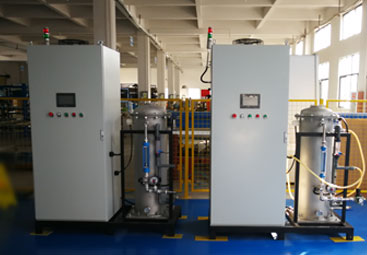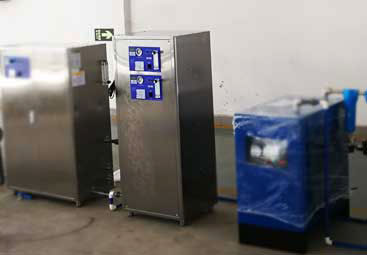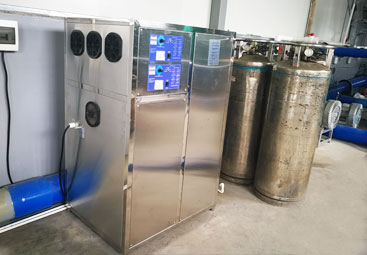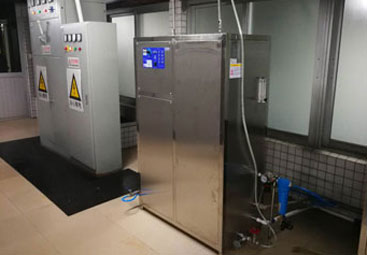Ozone generator solution for disinfecting pure water and min
Author:www.dahuan.net Views:date:2019-03-26 15:58
Ozone generator solution for disinfecting pure water and mineral water
First, the application of ozone in water treatment
Since the 1990s, trihalomethanes formed by the reaction of suspected organic matter and natural substances with oxygen have become carcinogenic, and countries such as the United States, Japan, and the United Kingdom have gradually become interested in the application of ozone in water treatment, and gradually An ozone treatment process is employed or added to the drinking water treatment system.
Since ozone has a higher oxidation potential than chlorine, it has a stronger bactericidal action than chlorine disinfection. The effect on bacteria is also faster than chlorine, the consumption is significantly smaller, and it is largely unaffected by the pH value. According to relevant reports, under 0.45mg/L ozone, the poliovirus will die after 2min; if disinfected with chlorine, it will take 3h when the dose is 2mg/L. When 1mL of water contains 274~325 coliforms, the number of enterobacteria can be reduced by 86% when the ozone dose is 1mg/L; when the dose is 2mg/L, the water can be completely disinfected.
Ozone disinfection has the following advantages over traditional chlorine disinfection methods:
(1) The disinfection can improve the properties of water and produce less chemical pollution;
(2) does not produce an odor such as chlorophenol;
(3) Disinfection by-products that do not produce chlorine disinfection such as trihalomethanes;
(4) Ozone can be produced in situ, and it only requires electrical energy to obtain it;
(5) In certain specific water sources, such as food processing, beverage production, and the microelectronics industry, ozone sterilization does not require an additional process of removing excess bactericide from purified water, such as a dechlorination process when sterilized with chlorine.
Because ozone is very unstable in water, it is easy to decompose. For example, there is still 0.4mg/L of residual ozone in the water at the mouth of the contact pool. However, after the stay in the clear water tank of the water plant, the residual ozone in the water is completely decomposed, and the water without residual disinfectant will be Entering the pipe network, ozone-sterilized tap water usually requires a small amount of chlorine or chloramine to be added before it enters the pipe network to maintain a certain level of disinfectant remaining in the water.
1. Main changes and disinfection mechanism of ozone
1) Main physical and chemical properties of ozone
Ozone is a highly reactive gas formed by the discharge of oxygen. Its molecular formula is O3, which is an allotrope of oxygen. The most striking feature of ozone is its strong odor. The English word for ozone is "OZONE", which is derived from Greek and means "taste." At normal temperature and pressure, ozone is a light blue gas with a strong pungent odor.
Ozone has a high oxidation potential (2.076V) and is more than 50% higher than chlorine (1.36V), so it has a stronger oxidation capacity than chlorine. Ozone is formed by oxygen in the following thermochemical equation:
3O3 — 2O3 — 69kcal
It can be seen from the above formula that the formation of ozone is an endothermic process. Therefore, the ozone molecules are extremely unstable and can be decomposed by themselves, and the energy is completely released along with the decomposition process. Therefore, ozone has a higher active oxidation capacity than oxygen.
2) The ability of ozone gas to transfer into water can also be expressed as:
Transfer capacity per unit time = transfer coefficient X exchange area X exchange potential
The exchange potential referred to herein is related not only to the difference in concentration of gas and liquid, but also to the activity of direct chemical reaction between ozone and water traits.
Many experiments have shown that ozone gas must be dissolved in water, firstly diffused on the surface of the liquid in contact with it and dissolved in the liquid on the surface, and finally diffused into the interior of the liquid. Therefore, the transfer rate between gas and liquid is mainly caused by the following Factor determined:
(1) physical properties of gas-liquid two phases;
(2) the depth difference of the gas passing through the gas-liquid interface;
(3) the extent of gas turbulence;
(4) The depth of ozone dissolved in water is greater than that of oxygen. The dissolution of ozone in water generally follows Henry's law. The main factors influencing the solubility of ozone in water are temperature and supply pressure. The effect of temperature on the solubility of ozone in water.
Since ozone is prepared locally by using air or oxygen at the site of use, the ozone concentration in the prepared ozone gas is usually very low, and the general weight concentration is between 2% and 10%. The ozone gas prepared is actually an oxygen oxidizing gas, which is a mixed gas containing a large amount of air and oxygen. Henry's law indicates the dissolution of a simple gas in water. Therefore, the solubility characteristics of ozone in water are related to the above-mentioned temperature and supply pressure, and also to the concentration of ozone in the gas supply. When a different concentration of ozonized gas is added to water at a certain temperature, the solubility of ozone in water changes with the change of air pressure.
In addition, the relationship between the concentration of ozone in water and the concentration of ozone in the gas supply is available at a certain atmospheric pressure.
Although the solubility of ozone in water is greater than that of oxygen, the ozone in the water is extremely unstable and easily decomposed. At a certain temperature, the pH has an effect on the rate of residual ozone decomposition in the water.
2. Oxidation reaction and disinfection mechanism of ozone
Once ozone is dissolved in water, the following two reactions occur: one is direct oxidation, which is a slower and more selective reaction; the other is hydroxyl in water, hydrogen peroxide, organic matter, humus And high concentration of hydroxide induced self-decomposition into hydroxyl radicals, indirectly oxidizing organic matter, microorganisms or ammonia. The latter reaction is quite fast and has no selectivity, and it is also possible to oxidize bicarbonate to bicarbonate and carbonic acid. The latter reaction is stronger and the oxidation ability is stronger in the two reactions.
Since hydroxide and organic matter can induce ozone to decompose into hydroxyl radicals by themselves, low pH conditions are beneficial to direct oxidation of ozone, while high pH and high organic matter are favorable for indirect oxidation of hydroxyl radicals. reaction.
The rate of self-decomposition of ozone depends to a large extent on pH, temperature, UV value, ozone concentration, and other remnants present in the water. The rate of decomposition can be indirectly expressed by the amount of residual ozone. Since bicarbonate and carbonate (especially carbonate) have strong buffering properties, residual ozone at low pH and high buffering performance can be maintained for a long time.
The role of ozone disinfection is mainly related to its high oxidation potential and its easy diffusion through the microbial cell membrane. Ozone can oxidize the organic matter of biological cells or destroy the chain structure of the organism to cause cell death. Therefore, ozone has a strong lethal effect on tenacious microorganisms such as viruses and spores.
In addition, while killing microorganisms, ozone can also oxidize various organic substances in water to remove package, smell, taste and phenol in water.
Second, the ozone disinfection system
Ozone generator solution for disinfecting pure water and mineral water
Ozone disinfection systems usually consist of four components, including gas source preparation, ozone generation, contact reactions, and tail gas treatment.
1. Gas source preparation, ozone generation
According to the operating characteristics of the ozone disinfection system, the gas source preparation part is a front system in the ozone disinfection system, and its function is to provide the ozone generator with the required quality and quantity of sufficient gas. The gas source preparation section is available in a variety of forms. The main considerations for the selection of different forms of gas source preparation are the size of the gas supply, site conditions and operating energy consumption.
The ozone generation is the core of the ozone disinfection system, and its role is to produce enough ozone gas for the disinfection process. Its investment accounts for more than 60% of the total ozone disinfection, and the operating energy consumption accounts for 60% to 80%. Part of the ozone generation varies depending on the form of the ozone generator. The factors to be considered in the selection of ozone are mainly ozone production, equipment investment, and operating energy consumption.
The contact reaction is the core of the production operation of the ozone disinfection system. Its function is to rapidly and efficiently diffuse the ozone gas into the treated water and stably and reliably complete the reaction required by the predetermined process. The determination of the form of the contact reaction depends primarily on the process objectives and their corresponding reactions.
Relative to other parts of the ozone disinfection system, the exhaust gas treatment part is a relatively independent subsystem, and its role is to eliminate the ozone disinfection system in a timely and effective manner.
Ozone has high corrosion resistance due to its strong oxidizing power. Usually rubber, most plastics, EPDM (ethylene, propylene copolymerization), ordinary steel and iron, copper, aluminum and other materials can not be used in the ozone system. Available materials mainly include 316 and 305 stainless steel, glass, HYPLAON (chlorosulfonated polyethylene synthetic rubber) TELON (polytetrafluoroethylene) and concrete.
2. Ozone contact
Ozone contact is the process of diffusing oxygen into a liquid and bringing it into full contact with the liquid and completing the desired reaction in a manner that is typically accomplished by an ozone contactor. Different process objectives and the same reaction determine the contact time in the form of a horn.
The main forms of ozone contactors are: conventional microbubble diffusion contactors, aspirating turbo diffusion contactors, closed contact columns with contact packing, and aspirating ejector diffusion contactors. For water purification, the form used is mainly microbubble diffusion and aspirating turbo diffusion.
The oxygen exposure time is usually between 1 and 12 minutes for different reactions. Where reliable virus elimination is required, it is often necessary to maintain a residual ozone of 0.4 mg/L for 4 min contact time. Because of the bacteria in the water, it usually contains substances that react rapidly with ozone (such as substances that make up the color and smell of water). Therefore, the disinfection contact time is generally 10 minutes.
When a micro-foaming diffusion disinfection contactor is used, it is usually arranged as a double compartment and a three compartment contact chamber. The first is for the chemical ozone demand (low color and taste) of water, which is usually based on the amount of 0.4~1.0mg/L and the contact time of 4~6min. The function of the subsequent grid is mainly to kill the virus. The level of residual ozone at the entrance of the grid must be at least 0.4 mg/L, and the lower part of the grid should be filled with enough ozone to keep this level up to 4 min. time. The amount of ozone injected in the subsequent compartment is usually 0.4~0.6mg/L.
When using an aspirating turbo-diffusion contactor, since this type of contactor is like a complete quick mixer, in order to meet the time required for disinfection and the level of residual ozone, it is usually necessary to set up a dwelling tank or adopt a multi-stage arrangement. Since the turbine has the advantage of efficiently mixing the ozone gas with the water, the contact depth of the contactor does not need to be deep.
3, exhaust gas treatment
When the ozone is in contact with the water in the contactor, the gas discharged from the contactor exhaust pipe still contains a certain amount of residual ozone, and the gas containing residual ozone is called ozone tail gas. The amount of residual ozone in the exhaust gas is related to the contact method of ozone with water and the concentration of ozone maintained in the treated water, and generally accounts for about 1% to 5% of the total ozone.
A certain concentration of ozone in the air is harmful to the human body. People staying in the air with ozone 1 / 1 million for a long time, will cause irritability, fatigue and headaches. At higher temperatures, in addition to these symptoms, it increases nausea, nose bleeding, and mucous membrane inflammation. Frequent exposure to ozone can cause serious illness. In order to protect the ambient air, the allowable concentration of ozone in the air is required to be 0.1 mg/m3. Therefore, except for a few specific occasions, it is allowed to use the atmosphere and the dilution capacity to solve the exhaust gas externally. Generally, the ozone-rich tail gas is not directly discharged, and must pass through the remaining The destruction of ozone is added to the disposal.
The method of tail gas disposal usually has the usage method, heat decomposition method, chemical subtraction method, catalytic decomposition method and weighing method.
-- End --
Next Page :How to ozone disinfection of bottled water Previous Page:Swimming pool water disinfection ozone application technolog
We found other products you might like!
Similar article ranking
- Glossary of terms related to ozone
- Application of ozone in cold storage
- Can ozone generator remove formaldehyde
- Swimming pool water disinfection ozone application technolog
- The application of ozone in the car wash industry
- space disinfection equipment selecting
- Application of ozone generator in sewage treatment
- How long after ozone disinfection will the air return to a s
- Ozone generator solution for disinfecting pure water and min
- Application of ozone in washing water industry
Ozone Equipment
- 50g-100g Ozone Generator
- Portable Household Ozone Generator
- 40g-100g ozone & oxygen machine
- SOZ-10G ozone generator
- 40g-200g ozone & oxygen machine
- OW Series Oxygen Generator
- DH-A Dryer
- Negative Pressure Ozone Generator
Ozone Application
- Residential Air purification Application
- ozone Application in wastewater treatment
- Ozone application in aquarium
- Ozone Application in Aquaculture
- ozone Application in Pure water treatment
- Ozone application in swimming pools
Latest news articles
- Ozone generator components and functions
- Ozone generator air source comparison
- Application of ozone generator in sewage treatment
- Application of ozone in cold storage
- How to ensure that ozone concentrations in clean areas are u
- How long after ozone disinfection will the air return to a s
- Application of ozone in washing water industry
- Can ozone generator remove formaldehyde
- How to ozone disinfection of bottled water
- Ozone generator solution for disinfecting pure water and min
- Swimming pool water disinfection ozone application technolog
- The application of ozone in the car wash industry
- Glossary of terms related to ozone
- Swimming pool ozone generator sterilization principle
- space disinfection equipment selecting
- Precautions for selecting a space disinfection ozone generat
- Method for preparing ozone during swimming pool disinfection
- Warmly celebrate the 21st anniversary of BNP
- Ozone generator concentration constant constant system
- Textile and garment fabric ozone decolorization system




